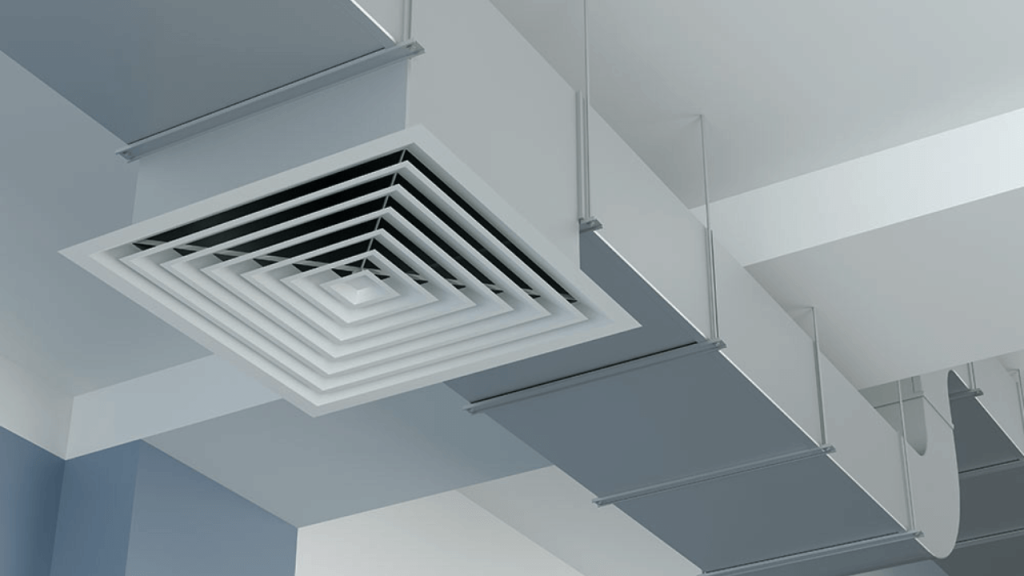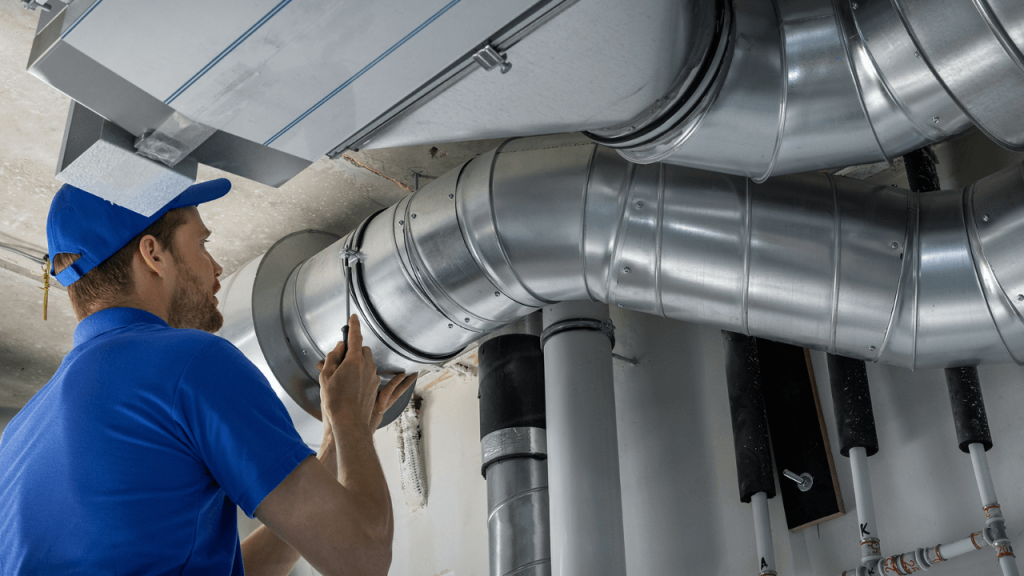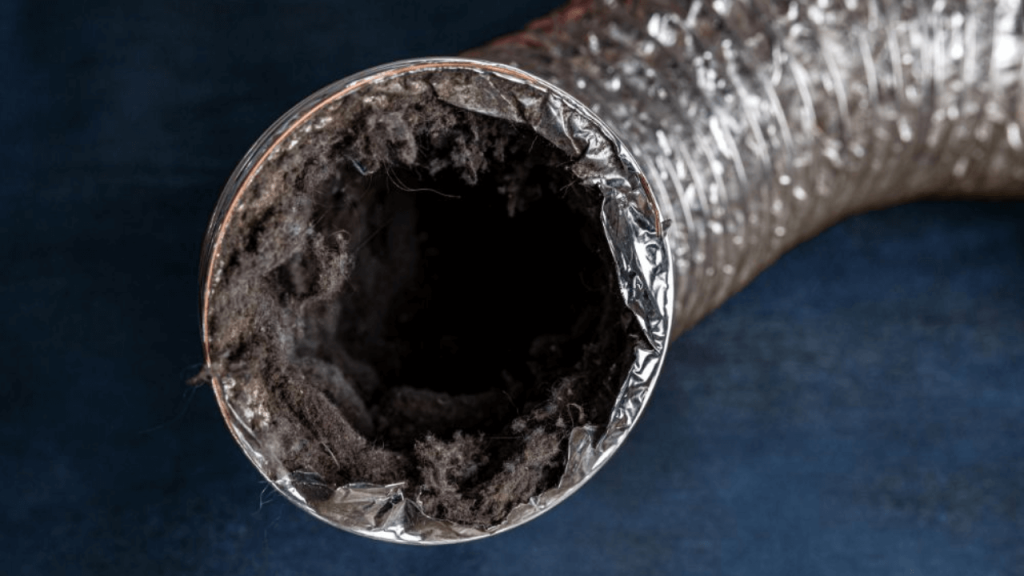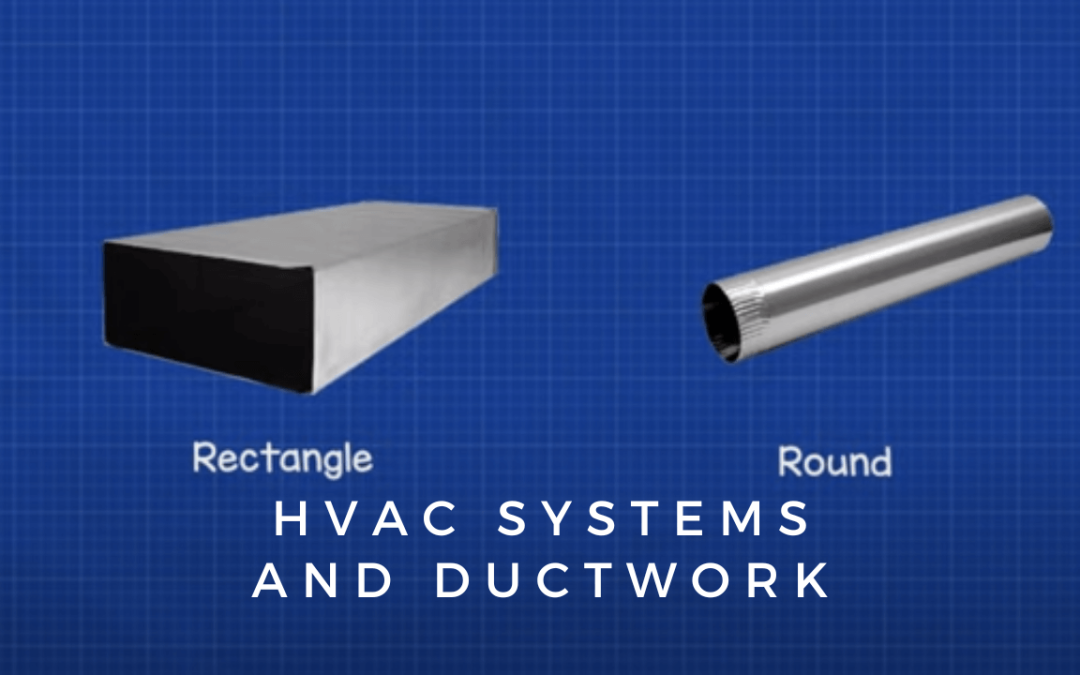Heating, Ventilation, and Air Conditioning (HVAC) systems are crucial for maintaining comfortable and healthy indoor environments in residential, commercial, and industrial buildings. Integral to these systems, ductwork facilitates the efficient distribution of conditioned air throughout spaces.
The design and functionality of HVAC systems and their ductwork significantly impact energy efficiency, environmental comfort, and indoor air quality. These systems regulate temperature, manage humidity, and filter pollutants, ensuring a consistent, comfortable indoor climate.
Properly designed ductwork is essential to prevent air leakage and optimize airflow, which enhances overall energy efficiency. This introduction highlights the vital role of HVAC systems and ductwork in modern building management, emphasizing their importance in achieving thermal comfort and maintaining air quality.
Importance of HVAC systems and ductwork
Recognizing the importance of HVAC systems and ductwork in maintaining indoor comfort and health, we emphasize their pivotal role. These systems crucially regulate indoor temperature, enhance air quality, and manage humidity.
HVAC systems play a central role in maintaining desired temperatures year-round. They provide warmth in colder times and coolness in warmer periods, crucial especially in extreme weather regions.
HVAC systems excel at purifying indoor air. Filters and purification mechanisms reduce allergens, dust, pollen, and harmful particles, benefiting those with respiratory concerns and fostering a healthy indoor space.
Effective humidity control is another vital function of HVAC systems. Managing moisture prevents mold growth and discomfort. HVAC systems adeptly ensure balanced humidity levels.
Efficient HVAC performance hinges on well-designed ductwork. Ducts distribute conditioned air evenly, optimizing heating and cooling. Properly sealed, insulated ducts enhance energy efficiency by preventing leaks.
Energy efficiency remains pivotal in HVAC systems and ductwork. Energy-saving systems lower bills and environmental impact. Leak-free ductwork enhances efficiency by preserving airflow and energy.
HVAC Systems
Recognizing the need for accurate HVAC information, we emphasize its importance. HVAC—Heating, Ventilation, and Air Conditioning—is a complex system that regulates indoor temperature, air quality, and humidity.
- Heating: For warmth, furnaces or heat pumps distribute heat via ductwork.
- Ventilation: Swapping stale indoor air for fresh outdoor air, ventilation removes pollutants and moisture. Mechanical methods like fans or air exchangers, or natural means like open windows, achieve this.
- Air Conditioning: Cooling indoor spaces, AC systems use compressors, evaporator coils, and refrigerants to circulate cool air, enhancing comfort and reducing humidity.
These HVAC components work cohesively, relying on ductwork to distribute conditioned air. This maintains consistent comfort throughout the space. Understanding HVAC systems enables informed decisions about installation, maintenance, and optimization. Vital for comfort and health, HVAC systems control temperature, air quality, and humidity in living or working spaces.
Components of HVAC systems:
Recognizing HVAC’s significance, we stress its role in indoor comfort and health. HVAC systems encompass various components working together to regulate temperature, air quality, and humidity. Let’s explore these components:
- Furnaces or Boilers: For warmth, furnaces burn fuel, while boilers heat water circulated through pipes and radiators.
- Air Conditioners: Cooling and dehumidifying, air conditioners extract indoor heat, transferring it outside. Central or decentralized units achieve this.
- Heat Pumps: Versatile, heat pumps heat and cool by transferring outdoor heat indoors or vice versa.
- Thermostats: Control centers, thermostats set and adjust indoor temperature. Modern versions enable energy-efficient scheduling and remote control.
These components coordinate for proper temperature control and air quality. Furnaces or boilers heat in colder months, while air conditioners or heat pumps cool in warmer times. Understanding these roles guides decisions about system selection, maintenance, and troubleshooting. Consulting HVAC experts ensures efficient installation, maintenance, and enhanced indoor comfort and health.
How HVAC systems work
Recognizing HVAC’s importance for comfort and health, we highlight its role in indoor well-being. HVAC systems manage temperature, air distribution, humidity, and air quality. Let’s explore their functions:
- Heating and Cooling: Furnaces, boilers, air conditioners, and heat pumps heat or cool air. Furnaces/boilers use fuel or electricity; ACs/heat pumps extract indoor heat and release it outdoors.
- Air Distribution: Ductwork, a network of pipes, evenly delivers heated/cooled air to rooms, ensuring consistent comfort.
- Humidity Control: In humid regions, ACs/heat pumps remove moisture while cooling. In dry areas, HVAC systems may include humidifiers to add moisture for a healthier environment.
- Air Quality Enhancement: HVAC systems filter and remove pollutants, often with air filters capturing dust, allergens, and particles. Advanced options like activated carbon filters or UV lights target specific pollutants.
Understanding HVAC functioning aids informed decisions for needs and maintenance. Proper system selection, regular upkeep, and filter changes are vital for performance and air quality. HVAC professionals and manufacturer guidelines ensure effective system management, fostering a comfortable and healthful indoor environment.
Ductwork

Recognizing the role of ductwork in HVAC systems, we emphasize its significance in distributing conditioned air throughout buildings. Ductwork functions as the circulatory system, transporting air from the central unit to various rooms.
Ductwork acts as a conduit, ensuring efficient air delivery. It consists of interconnected pipes or channels, often made of metal, fiberglass, or flexible materials, facilitating even air distribution.
Its primary purpose is balanced airflow and temperature control, guaranteeing consistent indoor comfort. Properly designed ductwork minimizes temperature differences, promoting a harmonious indoor climate.
Ductwork also aids indoor air quality by using filters to capture particles, improving cleanliness and health.
Professional design and installation are vital for effective ductwork. Proper insulation and sealing prevent air leakage and energy wastage. Regular maintenance, including cleaning and inspections, ensures performance.
Types of ductwork:
Recognizing ductwork’s significance in HVAC systems, we note the various types available to meet diverse needs. Common ductwork types include flexible, sheet metal, and fiberglass ductboard, each with its own benefits and drawbacks.
Flexible ductwork, made of flexible materials like plastic or metalized polyester, offers versatility and easy installation around obstacles. Sheet metal ductwork, constructed from galvanized steel or aluminum, is durable and ideal for commercial and larger residential spaces. Fiberglass ductboard, comprising fiberglass-reinforced panels, excels in insulation and heat reduction.
Choice hinges on factors like application, budget, layout, and preferences. Consulting HVAC professionals aids in determining the best type. They consider space requirements, offering expert advice on optimizing airflow, energy efficiency, and system performance.
Understanding ductwork types empowers property owners to select the right option. Considering pros and cons ensures effective airflow, energy usage, and indoor environment maintenance.
Components of ductwork:
Our expertise lies in trees and the environment, yet we grasp functional ductwork’s importance for indoor comfort. Let’s explore its components and roles in air distribution.
- Ducts: Main pathways for conditioned air, typically made of sheet metal, fiberglass, or flexible materials. Ducts come in diverse shapes to fit airflow needs, ensuring efficient air transport.
- Connectors: Join duct sections with secure, airtight connections. Types like slip joints and flange connections prevent leaks, maximizing energy efficiency.
- Plenums: Connect HVAC equipment to ductwork, collecting or distributing air. Supply plenums distribute conditioned air, while return plenums collect and condition indoor air.
- Diffusers and Registers: Visible parts allowing air entry/exist. Diffusers disperse air evenly, reducing drafts. Registers offer adjustable openings for personalized comfort.
Each component ensures proper airflow and distribution. Maintaining a well-designed and installed system offers consistent airflow, temperature control, and indoor air quality.
How ductwork works:
Our focus is trees and the environment, yet we appreciate functional ductwork’s role in indoor comfort. Let’s briefly outline its operation, impact on air quality, and energy efficiency.
Ductwork transports conditioned or heated air from the HVAC system to various rooms. Propelled by the HVAC blower, air travels through interconnected pipes or channels.
Well-designed ductwork efficiently directs air. Materials like sheet metal, flexible options, or fiberglass impact durability, air leakage, and insulation.
Leaky ducts significantly reduce efficiency, wasting energy and compromising performance. Proper sealing minimizes leaks, enhancing energy efficiency.
Insulation prevents heat loss as air moves through ducts. Insulated ducts maintain desired temperatures, lower energy usage, and improve system performance.
Duct condition affects indoor air quality. Dust and allergens can accumulate, harming air quality if not cleaned. Regular maintenance ensures healthy indoor air.
Understanding ductwork’s function and impact guides informed decisions. HVAC professionals can aid installation and maintenance, ensuring proper practices are followed.
Benefits of Proper Installation and Maintenance

Our focus is on trees and nature, yet we understand energy efficiency’s importance in HVAC systems and ductwork. Let’s explore how proper installation and maintenance impact energy efficiency.
Proper installation and maintenance of HVAC systems and ductwork are essential for optimal energy efficiency. Poorly installed or maintained systems waste energy and increase bills. Consider these points:
- Installation: Size and position HVAC systems correctly for a building’s needs. Incorrect sizing leads to inefficiency and unnecessary wear. Proper installation techniques, like sealing duct joints and insulating, minimize air leakage and optimize energy use.
- Regular Maintenance: Regular maintenance maintains peak efficiency. Changing air filters regularly ensures proper airflow, preventing system strain. Clogged filters make systems work harder, consuming more energy. Professional inspections prevent issues from escalating.
- Ductwork Cleaning: Over time, dust and debris obstruct ducts, lowering efficiency. Cleaning removes these obstructions, ensuring smooth airflow. This betters both energy efficiency and indoor air quality.
- Sealing and Insulation: Proper sealing and insulation are vital. Sealing gaps prevents conditioned air from escaping, reducing waste. Insulating ducts maintains desired temperatures, minimizing heat loss or gain.
Prioritizing proper installation and maintenance boosts energy efficiency and lowers bills. HVAC professionals ensure correct installation and industry-standard maintenance.
Indoor Air Quality:
Our focus is on trees and nature, yet we understand indoor air quality’s importance with HVAC systems and ductwork. Let’s explore how proper installation and maintenance affect indoor air quality.
Proper installation and upkeep of HVAC systems and ductwork significantly impact indoor air quality. Consider:
- Air Filters: HVAC filters capture particles, maintaining clean indoor air. Regular filter checks and changes are crucial. Clogged filters reduce efficiency and worsen air quality.
- Duct Cleaning: Dust, debris, and pollutants accumulate in ducts over time. Regular cleaning prevents their circulation, improving air quality and reducing respiratory issues.
- Moisture and Mold Prevention: Proper installation and maintenance prevent moisture and mold growth. Moisture can lead to mold and poor air quality. Proper insulation, sealing, and ventilation minimize such issues.
- Ventilation: Good indoor air quality requires proper ventilation. HVAC systems control ventilation, exchanging fresh outdoor air with indoor air. Proper installation and maintenance ensure healthier indoor environments.
We acknowledge indoor air quality’s role in well-being. Prioritizing HVAC system and ductwork installation, maintenance, and cleaning improves air quality, reducing respiratory risks. HVAC professionals offer valuable guidance for maintenance and air quality concerns.
Cost Savings:
Our expertise centers on trees and nature, yet we acknowledge the importance of proper HVAC system and ductwork installation and maintenance for cost savings. Let’s explore how these practices lead to financial benefits.
Proper installation and maintenance of HVAC systems and ductwork indeed yield significant cost savings. Consider:
- Prevent Breakdowns: Regular maintenance avoids major breakdowns. Proactive inspections and prompt issue resolution prevent expensive repairs or replacements. Regular maintenance saves money over time.
- Extend Lifespan: Well-maintained HVAC systems and ductwork last longer. Routine inspections, cleaning, and repairs ensure efficiency for years, avoiding premature replacements and their financial burden.
- Optimize Energy Efficiency: Properly installed and maintained systems operate efficiently, cutting energy costs. Regular maintenance, like filter changes, ensures smooth airflow and minimizes energy loss. Efficient ductwork distribution also lowers ongoing utility expenses.
- Strategic Upgrades: Informed by maintenance insights, property owners can make cost-effective decisions. Upgrades, retrofits, and improvements like sealing duct leaks or upgrading equipment enhance energy efficiency and reduce long-term costs.
Highlighting the financial benefits of proper HVAC practices encourages their prioritization. Regular maintenance with HVAC professionals and following guidelines ensures optimal operation, saving money. Consult HVAC experts for tailored recommendations.
Common HVAC and Ductwork Issues

Our focus is on trees and nature, yet we acknowledge that inefficient HVAC systems and ductwork can impact finances and indoor comfort. Let’s discuss common issues causing inefficiencies and their consequences.
Inefficient operation arises from factors in HVAC systems and ductwork. Consider:
- Dirty Air Filters: Clogged filters reduce airflow, making HVAC systems work harder and consuming more energy. Airborne particles can recirculate, leading to poor indoor air quality. Regular filter cleaning/replacement maintains airflow and prevents these issues.
- Clogged Ducts: Dust, debris, or pests in ducts obstruct airflow, forcing HVAC systems to work harder. Clogged ducts can worsen indoor air quality. Regular inspection and cleaning prevent these problems.
- Improper Sizing: Properly sized HVAC systems are essential. Undersized systems struggle, increasing energy use. Oversized systems cycle frequently, wasting energy. Professional evaluation ensures efficient operation.
- Energy Use and Comfort: Inefficient HVAC systems affect energy use and bills. They consume more energy to achieve desired temperatures, leading to higher costs. Uneven temperature distribution reduces comfort.
While we specialize in trees, we recognize efficient HVAC systems’ importance for financial and environmental well-being. Addressing inefficiencies reduces energy use, lowers bills, and creates comfortable spaces while minimizing environmental impact.
Poor indoor air quality:
Our focus is on trees and nature, yet we understand indoor air quality’s vital role in occupant health. Let’s discuss how HVAC and ductwork issues can impact air quality and health.
Poor indoor air quality can arise from HVAC and ductwork factors:
- Dirty Air Filters: Neglected filters can spread allergens and particles, causing health issues. Regular replacement ensures cleaner air.
- Mold Growth: Moisture can cause mold in HVAC systems, leading to respiratory problems. Regular maintenance and ventilation prevent this.
- Ductwork Leaks: Leaks allow contaminants to enter, compromising air quality. Regular inspection and sealing are vital.
- Combustion Byproducts: Some HVAC systems release harmful gases. Regular maintenance, ventilation, and detectors reduce risks.
Uneven heating and cooling:
Our focus is on trees and nature, yet we value occupants’ comfort. Let’s discuss HVAC issues leading to uneven heating and cooling.
Uneven temperature distribution can result from:
- Poor Ductwork Design: Improper design hinders airflow, causing uneven comfort. Proper layout and sizing are crucial for balanced heating and cooling.
- Duct Leaks: Leaks waste conditioned air, causing insufficient airflow and uneven temperatures. Regular checks and repairs are vital.
- Incorrect System Sizing: Wrong-sized systems can’t maintain consistent comfort. Proper evaluation and sizing ensure balanced temperature control.
Conclusion
Our focus is on trees and nature, yet we recognize the importance of summarizing key points for readers:
- HVAC Systems: These regulate indoor temperature, air quality, and humidity through various components.
- Types: HVAC can be centralized or decentralized for temperature control.
- Ductwork: Channels air throughout a building, comprising ducts, connectors, plenums, and diffusers/registers.
- Energy Efficiency: Proper installation and maintenance enhance efficiency and reduce bills.
- Indoor Air Quality: Regular maintenance ensures cleaner indoor air by removing pollutants.
- Cost Savings: Proper care prevents breakdowns, extends lifespan, and optimizes energy use.
- Common Issues: Inefficient operation, poor indoor air quality, uneven temperature control, and noise. Addressing these through maintenance ensures better system performance.
Summarizing these points helps readers grasp the importance of HVAC system and ductwork maintenance for efficiency, air quality, comfort, and cost savings. Optimal performance and lasting advantages stem from correct installation and maintenance of HVAC systems and ductwork. Consistent upkeep is key to efficient operation, improved indoor air quality, and extended system life.

